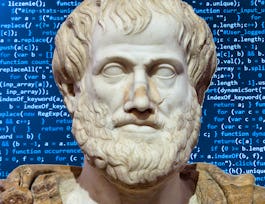Data is everywhere. Charts, graphs, and other types of information visualizations help people to make sense of this data. This course explores the design, development, and evaluation of such information visualizations. By combining aspects of design, computer graphics, HCI, and data science, you will gain hands-on experience with creating visualizations, using exploratory tools, and architecting data narratives. Topics include user-centered design, web-based visualization, data cognition and perception, and design evaluation.


Fundamentals of Data Visualization
This course is part of Vital Skills for Data Science Specialization
Taught in English
Some content may not be translated

Instructor: Danielle Szafir
5,724 already enrolled
Included with 
Course
(23 reviews)
Recommended experience
What you'll learn
Develop a toolkit for exploring and communicating complex data using visualization
Produce basic data visualizations using a chosen dataset
Compare methods for visualizing data and understand how these methods may guide users towards different conclusions
Evaluate how effectively a visualization conveys target data
Skills you'll gain
Details to know

Add to your LinkedIn profile
3 quizzes
Course
(23 reviews)
Recommended experience
See how employees at top companies are mastering in-demand skills

Build your subject-matter expertise
- Learn new concepts from industry experts
- Gain a foundational understanding of a subject or tool
- Develop job-relevant skills with hands-on projects
- Earn a shareable career certificate


Earn a career certificate
Add this credential to your LinkedIn profile, resume, or CV
Share it on social media and in your performance review

There are 3 modules in this course
In this module, you will learn the foundations of visualization design. You will walk through the key components of a visualization, how we effectively represent data using channels like color, size, and position, and some ground rules for honest and effective visualization. You will also gain preliminary exposure to Altair, a Python library for rapidly generating interactive visualizations. Each week will also include either two readings or one reading and one notebook activity.
What's included
13 videos14 readings1 quiz2 discussion prompts2 ungraded labs
In this module, you will learn how to choose the right visualization for a given scenario. You will learn how to reason about the different kinds of questions people ask with visualization and, how to align your design with that task. The module will cover basics of task analysis, methods for task elicitation, and foundational knowledge of visual perception for design. Each week will also include two external readings or one reading and one notebook activity.
What's included
9 videos7 readings1 quiz1 discussion prompt
In this module, you will learn how to assess the effectiveness of your visualization. You will learn both qualitative and quantitative approaches for evaluating visualizations as well as how to isolate key elements for assessment and iteration. The module will cover basics of insight-based evaluation, interview studies, and experimental design and analysis. Each week will also include two external readings or one reading and one notebook activity.
What's included
7 videos7 readings1 quiz1 discussion prompt
Instructor

Offered by
Recommended if you're interested in Data Analysis

Coursera Project Network

University of Colorado Boulder

University of Colorado Boulder

University of Colorado Boulder
Get a head start on your degree
This course is part of the following degree programs offered by University of Colorado Boulder. If you are admitted and enroll, your coursework can count toward your degree learning and your progress can transfer with you.
Why people choose Coursera for their career




Learner reviews
Showing 3 of 23
23 reviews
- 5 stars
78.26%
- 4 stars
13.04%
- 3 stars
8.69%
- 2 stars
0%
- 1 star
0%
Reviewed on Dec 16, 2023
New to Data Analysis? Start here.

Open new doors with Coursera Plus
Unlimited access to 7,000+ world-class courses, hands-on projects, and job-ready certificate programs - all included in your subscription
Advance your career with an online degree
Earn a degree from world-class universities - 100% online
Join over 3,400 global companies that choose Coursera for Business
Upskill your employees to excel in the digital economy
Frequently asked questions
A cross-listed course is offered under two or more CU Boulder degree programs on Coursera. For example, Dynamic Programming, Greedy Algorithms is offered as both CSCA 5414 for the MS-CS and DTSA 5503 for the MS-DS.
· You may not earn credit for more than one version of a cross-listed course.
· You can identify cross-listed courses by checking your program’s student handbook.
· Your transcript will be affected. Cross-listed courses are considered equivalent when evaluating graduation requirements. However, we encourage you to take your program's versions of cross-listed courses (when available) to ensure your CU transcript reflects the substantial amount of coursework you are completing directly in your home department. Any courses you complete from another program will appear on your CU transcript with that program’s course prefix (e.g., DTSA vs. CSCA).
· Programs may have different minimum grade requirements for admission and graduation. For example, the MS-DS requires a C or better on all courses for graduation (and a 3.0 pathway GPA for admission), whereas the MS-CS requires a B or better on all breadth courses and a C or better on all elective courses for graduation (and a B or better on each pathway course for admission). All programs require students to maintain a 3.0 cumulative GPA for admission and graduation.
Yes. Cross-listed courses are considered equivalent when evaluating graduation requirements. You can identify cross-listed courses by checking your program’s student handbook.
You may upgrade and pay tuition during any open enrollment period to earn graduate-level CU Boulder credit for << this course/ courses in this specialization>>. Because << this course is / these courses are >> cross listed in both the MS in Computer Science and the MS in Data Science programs, you will need to determine which program you would like to earn the credit from before you upgrade.
MS in Data Science (MS-DS) Credit: To upgrade to the for-credit data science (DTSA) version of << this course / these courses >>, use the MS-DS enrollment form. See How It Works.
MS in Computer Science (MS-CS) Credit: To upgrade to the for-credit computer science (CSCA) version of << this course / these courses >>, use the MS-CS enrollment form. See How It Works.
If you are unsure of which program is the best fit for you, review the MS-CS and MS-DS program websites, and then contact datascience@colorado.edu or mscscoursera-info@colorado.edu if you still have questions.

